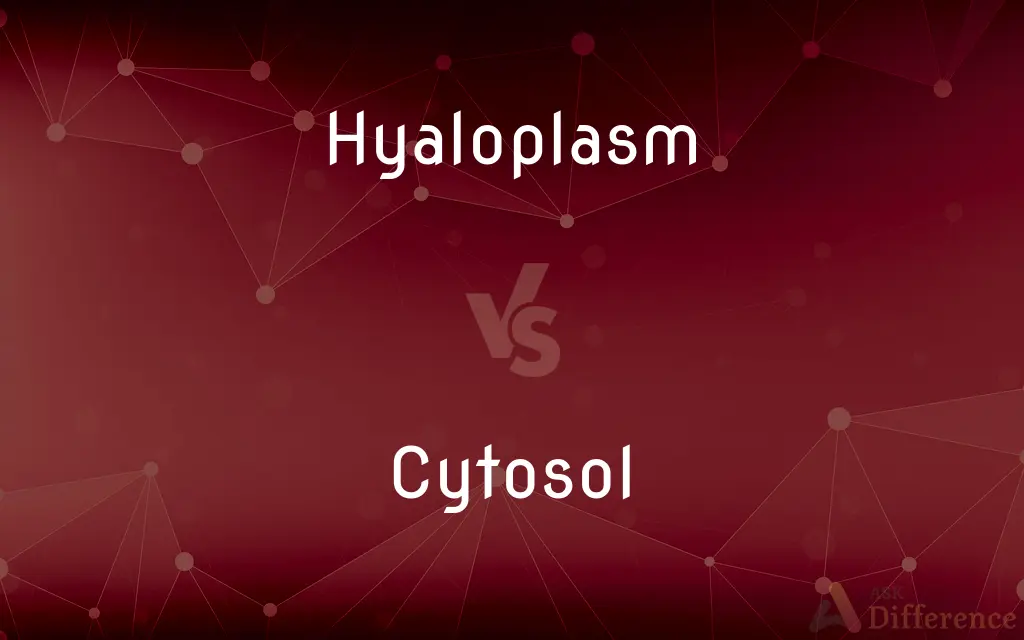Hyaloplasm vs. Cytosol — What's the Difference?
By Urooj Arif & Fiza Rafique — Updated on March 20, 2024
Hyaloplasm, a viscous fluid in cells, supports organelles; cytosol, a part of the cytoplasm, contains enzymes and the cytoskeleton.

Difference Between Hyaloplasm and Cytosol
Table of Contents
ADVERTISEMENT
Key Differences
Hyaloplasm, also known as the cell matrix, is the clear and soluble part of the cytoplasm in which cell organelles are suspended. It provides a medium for the biochemical activities that occur within the cell. On the other hand, the cytosol is the part of the cytoplasm that does not include the organelles but contains dissolved molecular substances such as proteins and ions.
While hyaloplasm acts primarily as a supportive and transport medium within the cell, providing a pathway for the distribution of nutrients and removal of waste products, the cytosol plays a crucial role in intracellular processes such as signal transduction and protein synthesis. It is enriched with enzymes that facilitate metabolic reactions.
The composition of hyaloplasm is largely water, but it also contains ions, proteins, and small molecules that contribute to its gel-like consistency. This consistency is vital for maintaining cell structure and providing mechanical support to the cell organelles. Conversely, the cytosol, while also primarily composed of water, has a higher concentration of enzymes and soluble proteins, making it the site of numerous biochemical reactions.
Hyaloplasm is involved in the movement and distribution of organelles within the cell, working closely with the cytoskeleton to ensure proper cell function and structure. Cytosol, however, is more directly involved in cellular metabolism and the synthesis of molecules, serving as the venue for processes such as glycolysis and the initial steps of protein synthesis.
In terms of functionality, while both hyaloplasm and cytosol are essential for cell survival and operation, their roles within the cell are distinct. Hyaloplasm is more about providing a supportive environment for organelles and maintaining cell integrity, whereas cytosol is actively engaged in the chemical processes necessary for life.
ADVERTISEMENT
Comparison Chart
Definition
The clear, soluble part of the cytoplasm.
The liquid part of the cytoplasm excluding organelles.
Main Function
Supports and transports organelles within the cell.
Facilitates metabolic reactions and protein synthesis.
Composition
Primarily water, with ions, proteins, and small molecules.
Water, with a higher concentration of enzymes and soluble proteins.
Role in Cell
Provides mechanical support and a medium for biochemical activities.
Hosts numerous biochemical reactions essential for cell metabolism.
Relation to Organelles
Surrounds and supports organelles.
Excludes organelles but includes soluble components.
Compare with Definitions
Hyaloplasm
Another term for hyaloplasm, emphasizing its role in providing structural support to cell components.
The cell matrix, or hyaloplasm, ensures that the organelles remain suspended within the cell.
Cytosol
The liquid part of the cytoplasm that is not enclosed within organelles, containing soluble proteins and enzymes.
The cytosol is bustling with metabolic activities crucial for the cell's survival.
Hyaloplasm
The clear, viscous fluid part of the cytoplasm in cells, excluding the organelles.
The hyaloplasm's gel-like consistency helps maintain the cell's shape and integrity.
Cytosol
Focuses on the aspect of cytosol being the fluid component within the cell membrane.
The intracellular fluid, or cytosol, contains dissolved nutrients essential for cellular functions.
Hyaloplasm
Refers to the base material in which cell organelles are embedded, synonymous with hyaloplasm.
The ground substance of the cell facilitates the transport of materials to and from the organelles.
Cytosol
Emphasizes the cytosol's role in the process of signal transduction within the cell.
The signal transduction medium facilitates the transmission of signals from the cell surface to its interior.
Hyaloplasm
Highlights the aspect of hyaloplasm being the soluble part of the cytoplasm.
The soluble cytoplasm is crucial for the diffusion of ions and molecules within the cell.
Cytosol
Highlights the cytosol's role in hosting metabolic pathways and reactions.
The metabolic compartment of the cell is where glycolysis and other energy-producing reactions take place.
Hyaloplasm
Emphasizes the structural and functional framework provided by the hyaloplasm.
The cytoplasmic matrix plays a vital role in cellular processes by hosting various enzymes and substrates.
Cytosol
Refers to the cytosol's role in the initial steps of protein synthesis.
Ribosomes in the cytosol are the sites where proteins are synthesized from amino acids.
Hyaloplasm
The clear fluid portion of cytoplasm as distinguished from the granular and netlike components. Also called ground substance.
Cytosol
The cytosol, also known as cytoplasmic matrix or groundplasm, is one of the liquids found inside cells (intracellular fluid (ICF)). It is separated into compartments by membranes.
Hyaloplasm
(microbiology) A structureless fluid in cells; cytosol
Cytosol
The fluid component of cytoplasm, excluding the organelles and insoluble components such as cytoskeletal protein filaments.
Hyaloplasm
The clear nongranular portion of the cytoplasm of a cell
Cytosol
(cytology) The aqueous solution of a cell's cytoplasm, consisting of water, organic molecules and inorganic ions.
Cytosol
The soluble components of the fluid matter enclosed within the cellular membrane; the portion of the cytoplasm which remains after removal of particulate components.
Cytosol
The aqueous part of the cytoplasm within which various particles and organelles are suspended
Common Curiosities
Can hyaloplasm and cytosol be considered the same?
No, hyaloplasm refers to the entire soluble part of the cytoplasm, including where organelles are suspended, whereas cytosol excludes the organelles.
What is the primary difference between hyaloplasm and cytosol?
Hyaloplasm is the clear fluid part of the cytoplasm that supports organelles, while cytosol is the part of the cytoplasm that excludes organelles but includes soluble substances.
What are the main components of cytosol?
The cytosol is primarily composed of water, with a high concentration of enzymes, ions, and soluble proteins.
How does hyaloplasm contribute to cell structure?
Hyaloplasm helps maintain cell shape and integrity through its viscous, gel-like consistency.
What is the significance of the cytosol in protein synthesis?
The cytosol hosts ribosomes for the initial steps of protein synthesis, making it essential for the production of proteins.
How does the composition of hyaloplasm and cytosol differ?
While both are primarily water-based, hyaloplasm contains more diverse molecules for support, whereas cytosol has a higher concentration of enzymes and proteins for metabolic activities.
How does the composition of the cytosol influence its function?
The composition of the cytosol, rich in enzymes, ions, and soluble proteins, directly influences its capacity to facilitate a wide range of biochemical processes essential for cell health and activity.
What role does hyaloplasm play in a cell?
Hyaloplasm provides mechanical support to cell organelles and serves as a medium for biochemical activities.
Do organelles exist within the hyaloplasm?
Yes, organelles are suspended within the hyaloplasm, which provides a supportive environment for them.
What is the role of enzymes in the cytosol?
Enzymes in the cytosol catalyze metabolic reactions, including energy production and macromolecule synthesis, crucial for cell survival and function.
Is the cytosol involved in cellular metabolism?
Yes, the cytosol is a crucial site for metabolic reactions, such as glycolysis and the initial steps of protein synthesis.
How do nutrients and waste products move through the hyaloplasm?
Nutrients and waste products diffuse through the hyaloplasm, leveraging its fluid nature for efficient transport to and from organelles and the cell membrane.
What role does the cytosol play in signal transduction?
The cytosol acts as a medium for signal transduction, allowing signaling molecules to traverse and initiate cellular responses, such as gene expression or enzyme activation.
How does the consistency of hyaloplasm affect cell function?
The gel-like consistency of hyaloplasm ensures that organelles remain properly positioned and supported, facilitating efficient cell function.
Share Your Discovery

Previous Comparison
Investment vs. Speculation
Next Comparison
Embellish vs. OrnamentAuthor Spotlight
Written by
Urooj ArifUrooj is a skilled content writer at Ask Difference, known for her exceptional ability to simplify complex topics into engaging and informative content. With a passion for research and a flair for clear, concise writing, she consistently delivers articles that resonate with our diverse audience.
Co-written by
Fiza RafiqueFiza Rafique is a skilled content writer at AskDifference.com, where she meticulously refines and enhances written pieces. Drawing from her vast editorial expertise, Fiza ensures clarity, accuracy, and precision in every article. Passionate about language, she continually seeks to elevate the quality of content for readers worldwide.















































